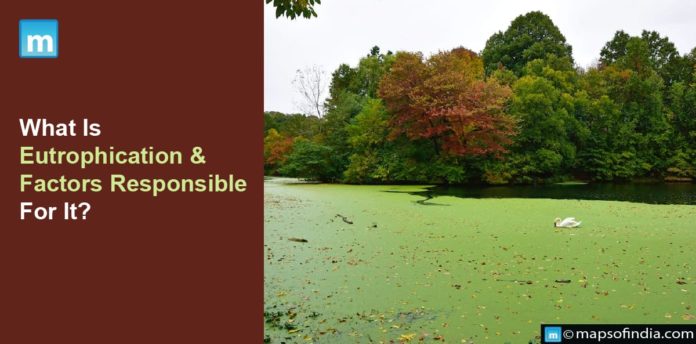Eutrophication is when a body of water, such as a lake or pond, becomes rich in nutrients, particularly phosphorus and nitrogen. These nutrients enter the water from various sources, including runoff from agricultural land, sewage treatment plants, and industrial activities. The excess nutrients lead to an overgrowth of aquatic plants and algae, which can cause a range of problems for both the environment and human health.
Factors responsible for Eutrophication:
-
Agricultural Activities:
Using fertilizers and other agricultural practices can cause excess nutrients to leach into the surrounding waterways. The runoff from these activities can lead to the growth of harmful algal blooms and other aquatic plant species.
-
Wastewater Treatment Plants:
Wastewater treatment plants can be a significant source of nutrients, mainly if they are not properly treated before being discharged into waterways. Sewage can contain high levels of nitrogen and phosphorus, contributing to the growth of harmful algal blooms.
-
Industrial Activities:
Many industrial activities, such as paper mills and food processing plants, can release excess nutrients into nearby waterways. These nutrients can contribute to the growth of harmful algal blooms and other aquatic plant species.
-
Urbanization:
Urbanization can increase the number of impervious surfaces, such as pavement and buildings, which can lead to increased runoff and erosion. This can result in more nutrients entering nearby waterways, contributing to Eutrophication.
-
Climate Change:
Climate change can also contribute to Eutrophication. As temperatures rise, algae and other aquatic plant species may grow more quickly, leading to more rapid Eutrophication.
Impact on the environment:
-
Harmful Algal Blooms:
Eutrophication can lead to the growth of harmful algal blooms, which can be toxic to humans and animals. These blooms can also deplete oxygen levels in the water, leading to the death of fish and other aquatic life.
-
Loss of Biodiversity:
Eutrophication can lead to a loss of biodiversity in the affected waterways. As the water becomes enriched with nutrients, certain species may thrive while others may be unable to compete.
-
Drinking Water Contamination:
Eutrophication can also impact drinking water sources. Harmful algal blooms can produce toxins that contaminate drinking water, making them unsafe for human consumption.
-
Decreased Recreational Value:
Eutrophication can reduce the recreational value of affected waterways. Algal blooms and other aquatic plant growth can make swimming and boating unpleasant or dangerous.
-
Economic Impact:
Eutrophication can have significant economic impacts, particularly for industries that rely on affected waterways. For example, the fishing and tourism industries may suffer due to the loss of biodiversity and decreased recreational value.
Conclusion
Eutrophication is a significant environmental problem caused by various factors, including agricultural activities, wastewater treatment plants, industrial activities, urbanization, and climate change. The impact of Eutrophication on the environment can be severe, including the growth of harmful algal blooms, loss of biodiversity, drinking water contamination, decreased recreational value, and economic impact. Addressing the causes of Eutrophication and implementing effective management strategies are crucial to protecting our water resources and the health of our ecosystems.




